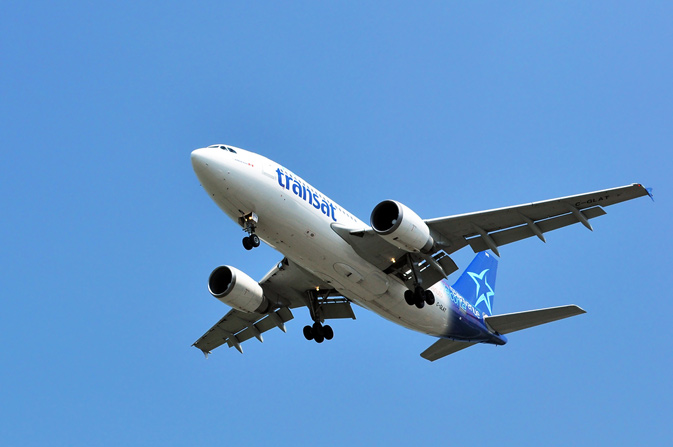MONTREAL — Transat A.T. Inc. posted revenues of $847.2 million for the quarter ended Jan. 31, compared with $805.7 million for the same period in 2013, an increase of $41.5 million, or 5.2%.
The corporation recorded an operating loss before amortization and depreciation of $23.8 million, compared with $21.0 million in 2013, and a net loss of $25.6 million ($0.67 per share on a diluted basis), compared with a net loss of $15.1 million ($0.39 per share on a diluted basis) in 2013.
The decline in value of the Canadian dollar alone resulted in increase in operating expenses of $14 million, said the company.
Before non-operating items, Transat reported an adjusted after-tax loss of $23.3 million in 2014 ($0.60 per share on a diluted basis), compared with $21.6 million ($0.56 per share on a diluted basis) in 2013.
“A substantial portion of the loss over this quarter is attributable to the sudden and rapid drop in the value of the Canadian dollar,” said Jean-Marc Eustache, President and Chief Executive Officer of Transat.
“This resulted in a significant increase in our operating expenses, which was offset only partially by higher selling prices and by our hedging program. That situation alone is what keeps us from posting improved results over last year at this time, both for the quarter and for the winter.
“However, our cost-control and margin-improvement program, which includes internalization of our narrow-body fleet, is unfolding as planned and delivering the expected results. We are on the right course.”
Revenues of North American business units, which are generated by sales in Canada and abroad, rose by $31.5 million (4.6%) compared with the same period in 2013. The increase stemmed from the increase in average selling prices, while the number of travellers decreased by 0.8%.
North American business operations resulted in an operating loss of $25 million, compared with one of $16.3 million in 2013. The higher operating loss is mainly attributable to the recent rapid depreciation of the Canadian dollar. The combined effect of increased selling prices plus cost-control initiatives was not sufficient to offset the effect of those expense increases, said the company.
Revenues of European business units, which are generated by sales in Europe and in Canada, increased by $10 million (8.7%) over 2013, owing to the strong performances of the euro and the pound against the Canadian dollar.
Measured in local currencies, those business units’ revenues declined, following the Corporation’s decision to reduce capacity. European operations resulted in a loss before amortization and depreciation of $8.6 million, compared with one of $13.7 million in 2013.
As at Jan. 31, the corporation’s free cash totalled $359.6 million, compared with $247.9 million at the same date in 2013. The working capital ratio was 1.07, against 1.02, and deposits from customers for future travel amounted to $621.6 million, compared with $592 million a year earlier.
Looking ahead to the second quarter, on the sun destinations market Transat’s capacity is approximately 2% lower than that commercialized last year. To date, 70% of that capacity has been sold, load factors are lower by 2%, and selling prices are higher by 4% compared with those recorded last year at the same date.
On the transatlantic market, also in low season, Transat’s capacity is 6% lower than that commercialized last winter. To date, 67% of that capacity has been sold, load factors are lower by 5%, and selling prices are higher by 2%.
The results report notes that the sun destinations market out of Canada “accounts for a substantial portion of Transat’s business during the winter season, and on that market, margins are particularly slim and volatile”.
Owing to the rapid recent decline in the value of the Canadian dollar, the corporation expects that its second-quarter results will be inferior to those posted for the corresponding quarter last year.
The weakening dollar by itself led to an increase in operating expenses of 2.7% in the first quarter for sun destinations, and of 3.4% in the second quarter for bookings made to date.
If the dollar remains at its current value, the increase in operating expenses for the second quarter overall resulting from the decline in the dollar’s value compared with the previous year will be 3.7%.
About 27% of seats have been sold for summer 2014 and Transat’s capacity on the transatlantic market is 1% higher than in 2013. Load factors are similar and prices are higher by 5%. The weakened Canadian dollar will mean an increase in operating expenses this summer, estimated to be 6% if the dollar remains at its current value against the U.S. dollar, the euro and the pound.
Transat A.T. says it is continuing with the implementation of the initiatives provided for in its return-to-profitability plan, including measures to reduce operating costs and changes to its systems and processes.
In April 2013, Transat announced its decision to internalize narrow-body medium-haul aircraft (Boeing 737-800s) for its sun destination routes outbound from Canada, starting in May 2014.
The various measures (cost-reduction initiatives, additional revenues and efficiency gains) had, as expected, a favourable impact of $20 million on the margin in 2012 and one of $15 million in 2013. The Corporation expects another $20 million in 2014, as well as in 2015, when internalization of the narrow-body fleet will produce its full benefits.

